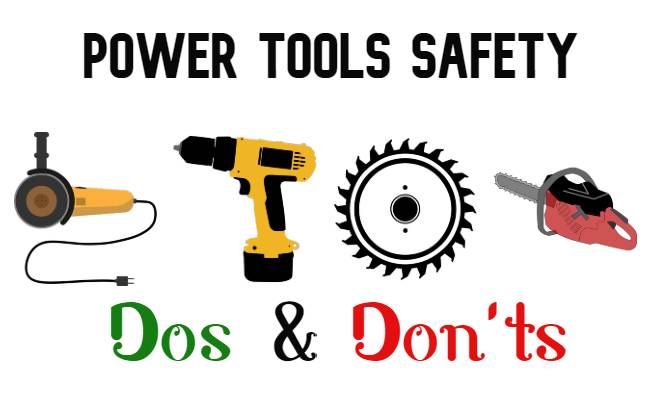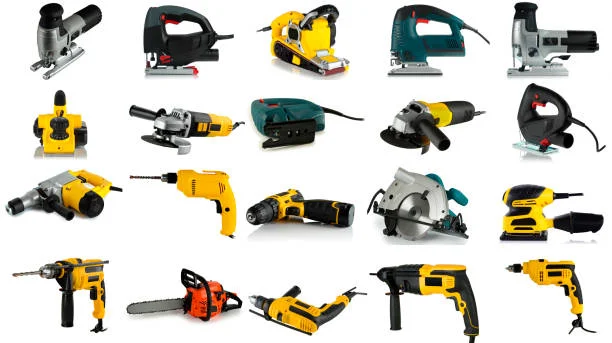Welcome to the world of power tools safety! You may be wondering, “What is power tools safety?” Well, let me break it down for you. Power tools safety is all about using these handy devices in a way that keeps you and those around you safe and sound.
Picture this: you’re in your garage or workshop, ready to tackle a project with your trusty power tools. Whether it’s drilling, cutting, or sanding, power tools can make your DIY dreams come true. But before you dive in, it’s crucial to understand the dos and don’ts of using these tools to prevent accidents and injuries.
In this guide, we’ll explore different aspects of power tools safety, from wearing the right protective gear to using the tools properly. So let’s dive in and empower ourselves with the knowledge to stay safe while getting the job done!

Understanding Power Tools Safety: Ensuring Protection and Efficiency
Power tools are essential for a wide range of tasks, from home improvement projects to professional construction work. However, the use of power tools also comes with inherent risks that need to be properly managed. Power tools safety is of utmost importance to prevent accidents and injuries. In this article, we will explore what power tools safety entails and offer valuable tips and guidance to ensure protection and efficiency in their use.
Why is Power Tools Safety Important?
Power tools can cause serious accidents if not used correctly or if safety precautions are not followed. It is crucial to prioritize safety when working with these tools, as even minor mistakes can lead to severe injuries. By following proper safety measures, you can prevent accidents, protect yourself and others involved, and enhance the overall efficiency and effectiveness of your work.
Incorporating Safe Handling and Operation Procedures
Safe handling and operation procedures are vital for power tools safety. Before using any power tool, it is crucial to read the user manual and familiarize yourself with its specific instructions, functions, and safety features. Always wear appropriate personal protective equipment (PPE), such as safety glasses, gloves, and ear protection, to safeguard against potential hazards. Ensure that the power tool is in good working condition and inspect it for any damage or defects before use.
When using a power tool, maintain a firm grip on it and avoid distractions or rushed movements. Keep your work area well-lit, clean, and organized to minimize the risk of accidents. Never operate a power tool if you are fatigued, under the influence of drugs or alcohol, or not mentally focused. It is also essential to maintain proper posture and positioning while using power tools and to avoid any awkward or unstable positions that could lead to slips, falls, or strain.
Implementing Effective Safety Measures
Alongside safe handling and operation procedures, implementing effective safety measures enhances power tools safety. Ensure that your work area is properly ventilated to prevent the buildup of fumes or dust, which can be harmful. Use a ground fault circuit interrupter (GFCI) when working with power tools near water or in damp environments to protect against electrocution.
Regularly inspect and maintain your power tools, checking for loose or damaged components, proper grounding, and correct blade or bit placement. Follow manufacturer recommendations regarding maintenance and lubrication to keep your tools in optimal condition. Store power tools in a secure location, out of reach of children and unauthorized individuals, and use lockout/tagout procedures when performing maintenance or repairs.
Providing Training and Education
Power tools safety can be further enhanced by providing proper training and education to those who will be using these tools. Whether you are a professional or a DIY enthusiast, understanding the correct usage and safety protocols is essential. Attend training sessions, workshops, or courses focused on power tools safety, where you can learn about potential hazards, risk assessment, and appropriate safety practices.
Promote a safety culture by sharing knowledge and best practices with colleagues, coworkers, or family members who may also use power tools. Emphasize the importance of following safety guidelines and staying up to date with new developments or advancements in power tools safety. Open communication and ongoing education play a crucial role in preventing accidents and fostering a safe working environment.
Choosing the Right Power Tool for the Task
When it comes to power tools safety, selecting the appropriate tool for the task at hand is crucial. Different power tools have varying capabilities and are designed for specific applications. By choosing the right tool, you can ensure better accuracy, increased productivity, and reduced risk of accidents.
The Importance of Ergonomics
Ergonomics plays a significant role in power tools safety and overall user comfort. Ergonomically designed tools minimize strain and fatigue, reducing the risk of accidents caused by poor grip, imbalance, or discomfort. Look for features such as comfortable handles, vibration-dampening mechanisms, and adjustable settings to enhance control and minimize physical stress on the body.
Weighing the Pros and Cons: Corded vs. Cordless Power Tools
When selecting a power tool, consider whether you require a corded or cordless option. Each has its own advantages and considerations regarding power source, portability, and convenience. Corded power tools provide continuous power but may limit mobility. Cordless power tools offer greater flexibility but are reliant on battery life and may require additional charging time. Evaluate the specific needs of your project to determine the most suitable option.
Benefits of Using Power Tools Safely
Using power tools safely provides numerous benefits, both for individuals and businesses. By prioritizing power tools safety, you can minimize the risk of accidents, reduce work-related injuries, and enhance overall productivity. A safe working environment instills confidence and trust among workers, leading to improved morale and job satisfaction. Furthermore, adhering to safety regulations and best practices can help businesses avoid legal repercussions and costly fines.
In conclusion, power tools safety should never be taken lightly. By incorporating safe handling and operation procedures, implementing effective safety measures, providing training and education, and choosing the right tool for the task, individuals can significantly reduce the risk of accidents and injuries. Prioritizing power tools safety ensures not only personal protection but also increased efficiency and productivity. Stay informed, abide by safety guidelines, and create a safe working environment for everyone involved in power tool usage.
Key Takeaways: What is Power Tools Safety?
- Always wear appropriate safety gear, such as goggles, gloves, and ear protection.
- Inspect power tools before use to ensure they are in good working condition.
- Follow the manufacturer’s instructions and guidelines for proper tool usage.
- Avoid distractions and maintain focus when operating power tools.
- Keep power tools away from children and store them in a secure location.
Frequently Asked Questions
When it comes to power tool safety, it’s important to have a clear understanding of how to use these tools safely to prevent accidents. Here are some frequently asked questions about power tool safety:
1. How can I ensure my safety while using power tools?
To ensure your safety while using power tools, there are a few key steps you should follow. First, always wear appropriate personal protective equipment, such as safety goggles and gloves, to protect yourself from potential hazards. Second, make sure the power tool is in good working condition and properly maintained. Inspect cords, switches, and blades for any damage before use. Third, familiarize yourself with the tool’s user manual and follow all instructions and safety precautions. Lastly, always use power tools in a well-lit area, away from distractions, and never leave them unattended while powered on.
By following these guidelines, you can significantly reduce the risk of accidents and ensure your safety while using power tools.
2. Are there any specific safety precautions I should take when using power tools around children?
When using power tools around children, it’s crucial to prioritize their safety as well. First and foremost, keep all power tools and their accessories securely stored in a locked cabinet or out of children’s reach. Always supervise children and keep them at a safe distance from the work area. Educate them about the dangers of power tools and explain why they should never touch or operate them without adult supervision. Additionally, demonstrate responsible use of power tools by wearing appropriate protective gear and following all safety procedures. By setting a good example and teaching children about power tool safety, you can help prevent accidents and protect their well-being.
Remember, it’s important to create a safe environment and educate children about the potential dangers of power tools to ensure their safety at all times.
3. Can I use power tools in wet or damp conditions?
No, it is not safe to use power tools in wet or damp conditions. Water can conduct electricity and increase the risk of electrical shock. Additionally, moisture can damage the tools and compromise their functionality. If you need to work in wet or damp environments, make sure to use tools specifically designed for such conditions and follow all manufacturer recommendations. It’s crucial to prioritize your safety by avoiding the use of regular power tools in wet or damp conditions to prevent accidents and electrical hazards.
Always err on the side of caution and opt for alternative methods or tools that are specifically designed for wet or damp conditions.
4. How should I handle and store power tool batteries?
Proper handling and storage of power tool batteries are essential for safety. When handling batteries, always make sure your hands are dry and clean. Avoid exposing batteries to extreme temperatures or direct sunlight, as it can damage them or lead to leakage. If a battery shows signs of damage, such as bulging or leaking, do not use it and safely dispose of it according to the manufacturer’s instructions. To store batteries, keep them in a cool, dry place and avoid storing them loose or with metal objects that could cause a short circuit. By handling and storing power tool batteries correctly, you can minimize the risk of accidents, malfunctions, and damage.
Remember to always refer to the manufacturer’s guidelines for specific instructions on handling and storing power tool batteries.
5. What should I do if a power tool malfunctions or becomes damaged?
If a power tool malfunctions or becomes damaged, it is important to take immediate action to prevent further risks. First, stop using the tool immediately and unplug it from the power source. Assess the extent of the damage and determine if it can be repaired or if it needs to be replaced. If repairable, consult the manufacturer’s instructions or contact a professional for assistance. If the damage is significant or irreparable, dispose of the tool according to local regulations and guidelines. Never attempt to use a malfunctioning or damaged power tool as it can lead to accidents or further damage. Prioritize your safety by addressing the issue promptly and ensuring you have a working and safe tool for future use.
Always remember that safety should be the top priority when using power tools, and it’s important to address any malfunctions or damage to maintain a safe working environment.

Summary
Power tools can be really cool and useful, but they can also be dangerous if not used correctly. It’s super important to follow safety rules to avoid accidents. Always wear protective gear, like goggles and gloves. Make sure the power tool is in good condition and use it for the right job. Keep your hands and fingers away from the moving parts, and never, ever leave a power tool unattended. By being smart and cautious, you can enjoy using power tools safely and have fun DIYing!
